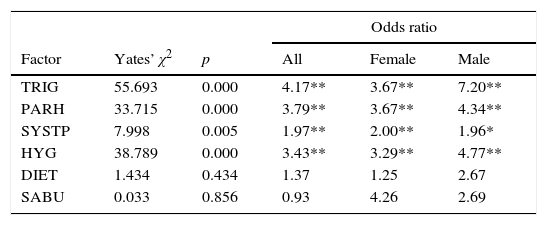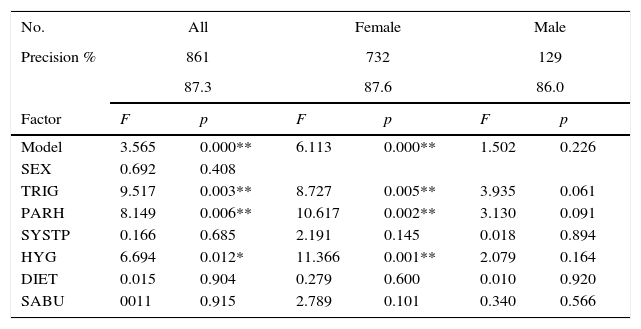Burning mouth syndrome (BMS) can be defined as burning pain or dysesthesia on the tongue and/or other sites of the oral mucosa without a causative identifiable lesion. The discomfort is usually of daily recurrence, with a higher incidence among people aged 50–60 years, affecting mostly the female sex and diminishing their quality of life. The aim of this study was to evaluate the association between several pathogenic factors and burning mouth syndrome.
Patients and methods736 medical records of patients diagnosed of burning mouth syndrome and 132 medical records for the control group were studied retrospectively. The study time span was from January 1990 to December 2014. The protocol included: sex, age, type of oral discomfort and location, among other factors.
ResultsAnalysis of the association between pathogenic factors and BMS diagnosis revealed that only 3 factors showed a statistically significant association: triggers (p=.003), parafunctional habits (p=.006), and oral hygiene (p=.012). There were neither statistically significant differences in BMS incidence between sex groups (p=.408) nor association of BMS with the pathogenic factors of substance abuse (p=.915), systemic pathology (p=.685), and dietary habits (p=.904).
ConclusionsParafunctional habits like bruxism and abnormal movements of tongue and lips can explain the BMS main symptomatology. Psychological aspects and systemic factors should be always considered. As a multifactorial disorder, the treatment of BMS should be executed in a holistic way.
El síndrome de boca ardiente (SBA) puede definirse como ardor o disestesia en la lengua y/u otras áreas de la mucosa bucal, en ausencia de lesiones que puedan justificarlo. Su incidencia es mayor en pacientes de sexo femenino, de edades comprendidas entre 50 y 60 años. Estas molestias suelen recurrir diariamente, provocando un deterioro de la calidad de vida. El objetivo del estudio fue evaluar la asociación entre diversos factores patogénicos y el SBA.
Pacientes y métodosSe estudiaron de forma retrospectiva 736 historias clínicas de pacientes diagnosticados de SBA y 132 historias clínicas de pacientes control. El período de estudio se extendió desde enero de 1990 a diciembre de 2014. El protocolo incluyó: sexo, edad, tipo de molestia bucal y localización, entre otras variables.
ResultadosEl análisis de la asociación entre los factores patogénicos y el diagnóstico de SBA mostró significación estadística en solo 3 de ellos: factores desencadenantes (p=0,003), hábitos parafuncionales (p=0,006) e higiene oral (p=0,012). No se encontraron diferencias significativas en la incidencia del SBA por sexos (p=0,408), ni asociación entre el SBA y los factores de abuso de sustancias (p=0,915), patología sistémica (p=0,685) y hábitos alimentarios (p=0,904).
ConclusionesLos hábitos parafuncionales como el bruxismo y los movimientos anormales de la lengua y labios pueden explicar la sintomatología del SBA. Hay que tener siempre en cuenta los aspectos psicológicos y los factores sistémicos. Como alteración de carácter multifactorial que es, el tratamiento del SBA debe enfocarse de manera holística.









